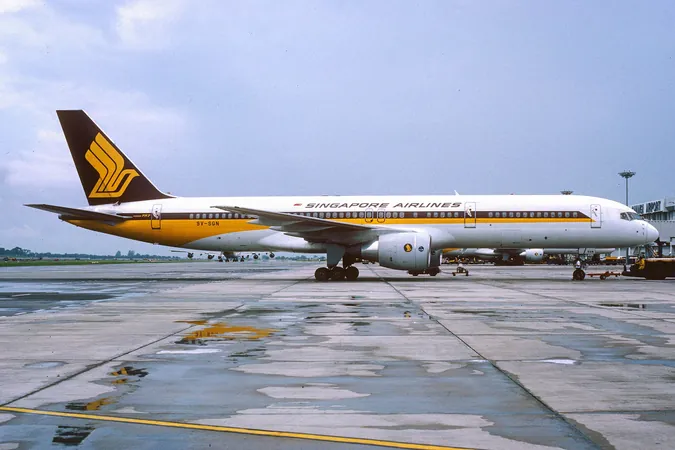
The Fascinating yet Fleeting Era of Singapore Airlines’ Boeing 757s
2025-01-25
Author: Wei Ling
Introduction
In a bold move back in 2021, Singapore Airlines redefined its fleet strategy by introducing its first narrow-body passenger aircraft in over three decades. This notable step saw the addition of nine former SilkAir Boeing 737-800s, aimed at streamlining operations within the Airline Group into a single full-service entity alongside a low-cost carrier. The arrival of the Boeing 737-8 MAX later that year marked further modernization efforts.
The Last Narrow-Body Aircraft
But what about the last narrow-body aircraft Singapore Airlines operated? To understand its brief foray into the single-aisle market, we need to travel back to 1990 and examine the airline’s short-lived venture with just four Boeing 757s.
Why the Boeing 757? A Strategic Decision
Singapore Airlines' exploration of the Boeing 757 came during the early 1980s, a period when the airline was looking to update its regional fleet, replacing six Boeing 727s. The options narrowed down to either the twin-aisle Airbus A310 or the single-aisle Boeing 757-200. Interestingly, rather than selecting one over the other, Singapore Airlines adopted an innovative approach: introducing both models to their fleet.
Boeing's 757: A Timeless Choice in Other Regions
While the Boeing 757 is often overlooked in the Asia-Pacific region, it enjoyed immense popularity in North America and Europe as a high-density aircraft capable of efficiently servicing long intra-continental routes. Over 1,000 of the aircraft were produced, with a mere 77 delivered to Asia-Pacific carriers, underlining its limited appeal in this area.
A Milestone Delivery
On November 12, 1984, Singapore Airlines took delivery of its first Boeing 757 in Seattle. After training, it arrived in Singapore by the month’s end, marking a significant addition to the airline's fleet. The 757s, accommodating 180 passengers, entered commercial service on December 9, 1984, coinciding with extensive advertising campaigns aimed at boosting its presence in Singapore.
The Route Network: Brief yet Busy
By December 1986, the Boeing 757s primarily served four routes: Jakarta, Kuala Lumpur, Medan, and Penang. They were consistently busy, completing an impressive 136 sectors a week across the fleet, primarily focusing on Malaysia and Indonesia.
The A310 Wins Out: Factors Behind the Decision
Despite the initial excitement, passenger feedback favored the A310’s wider cabin, quicker loading capabilities, and more substantial freight capacity. By mid-1985, SIA began phasing out the 757 in favor of the A310, a decision supported by both operational efficiency and cargo needs.
What Became of the Fleet?
SIA sold the four Boeing 757s to the International Lease Finance Corporation (ILFC) after just five years. They eventually found a new home with American Trans Air and later joined Delta Air Lines, where they enjoyed a commendable life span of over 20 years before being scrapped in 2017.
Reflections on a Brief Era
While the 757s were short-lived in Singapore Airlines' operations, they showcased the airline's willingness to innovate during a time of transition. A wider fleet of 757s might have been an intriguing direction, but SIA's choice to go with the Airbus A310 not only reflected market realities but also the airline's long-term vision.
Fast forward to today, Singapore Airlines has embraced narrow-body aircraft once again. With its current fleet of Boeing 737-800s and a commitment to 29 Boeing 737 MAX 8 jets—featuring luxurious flat-bed seats in Business Class—a thrilling future awaits.
Call to Action
Did you ever have the chance to fly on a Singapore Airlines Boeing 757? Share your memories below!



 Brasil (PT)
Brasil (PT)
 Canada (EN)
Canada (EN)
 Chile (ES)
Chile (ES)
 Česko (CS)
Česko (CS)
 대한민국 (KO)
대한민국 (KO)
 España (ES)
España (ES)
 France (FR)
France (FR)
 Hong Kong (EN)
Hong Kong (EN)
 Italia (IT)
Italia (IT)
 日本 (JA)
日本 (JA)
 Magyarország (HU)
Magyarország (HU)
 Norge (NO)
Norge (NO)
 Polska (PL)
Polska (PL)
 Schweiz (DE)
Schweiz (DE)
 Singapore (EN)
Singapore (EN)
 Sverige (SV)
Sverige (SV)
 Suomi (FI)
Suomi (FI)
 Türkiye (TR)
Türkiye (TR)
 الإمارات العربية المتحدة (AR)
الإمارات العربية المتحدة (AR)